[TIPS]: Sun Protection Basic Guide
abril 06, 2018*¡VERSIÓN EN ESPAÑOL AQUÍ!
Hello again! (~ ̄▽ ̄)~ Spring's here in Mexico and sun it's an important business, so I wanted to create a resume (like a guide) about solar protection, because sunscreens are really important into our skincare routine. I know that when you read "sunscreen" you think inmediately in that greasy and white texture that leaves meanwhile we spread it, and at least I used to relate with the public pool smell or with familiar trips to the beach, so why do we need suncreen if we're not going to the beach? I'll do my best to explain its importance into our daily routineヽ(^◇^*)/.
[Before we start, I'd like to say that this guide was written with basic notions about sunscreens and I tried to support it through reliable bibliographic sources, my intention is not to replace the function of experts such as dermatologists or medical specialists. You can take this guide as a starting point and ask your GP what it is best to use ◕‿‿◕].
+ COMMON QUESTIONS ABOUT SUNSCREENS +
Sunscreens are product that combine specific ingredients that help us to prevent the damage occasionated by Ultraviolet Radiation (UV) from sun rays.
By the way, these sunscreens was known as "sunblocks". The name changed because the FDA (Food and Drugs Administration) determined that it can be "blockers" since they don't block the sun rays effects totally, that's why the name was changed to "sunscreens". Same way for the terms "waterproof" and "sweatproof" are forbidden, and if a sunscreen clains to be "water resistant", it must specify the protection time when you're exposed to water or sweat (usually between 40-80 minutes).
The ultraviolet radiation (UV) is part of the sun electromagnetic spectrum that has contact with the Earth in form of sun rays. This radiation has waves from diverse sizes and a lot of them are imperceptible to the naked eye. And this is the wavelength that divide them in three great groups:
UVA, UVB and UVC. UVC rays are absorbed by the ozone layer, so the UVA and UVB can arrive to Earth and therefore to your skin.
UVA, UVB and UVC. UVC rays are absorbed by the ozone layer, so the UVA and UVB can arrive to Earth and therefore to your skin.
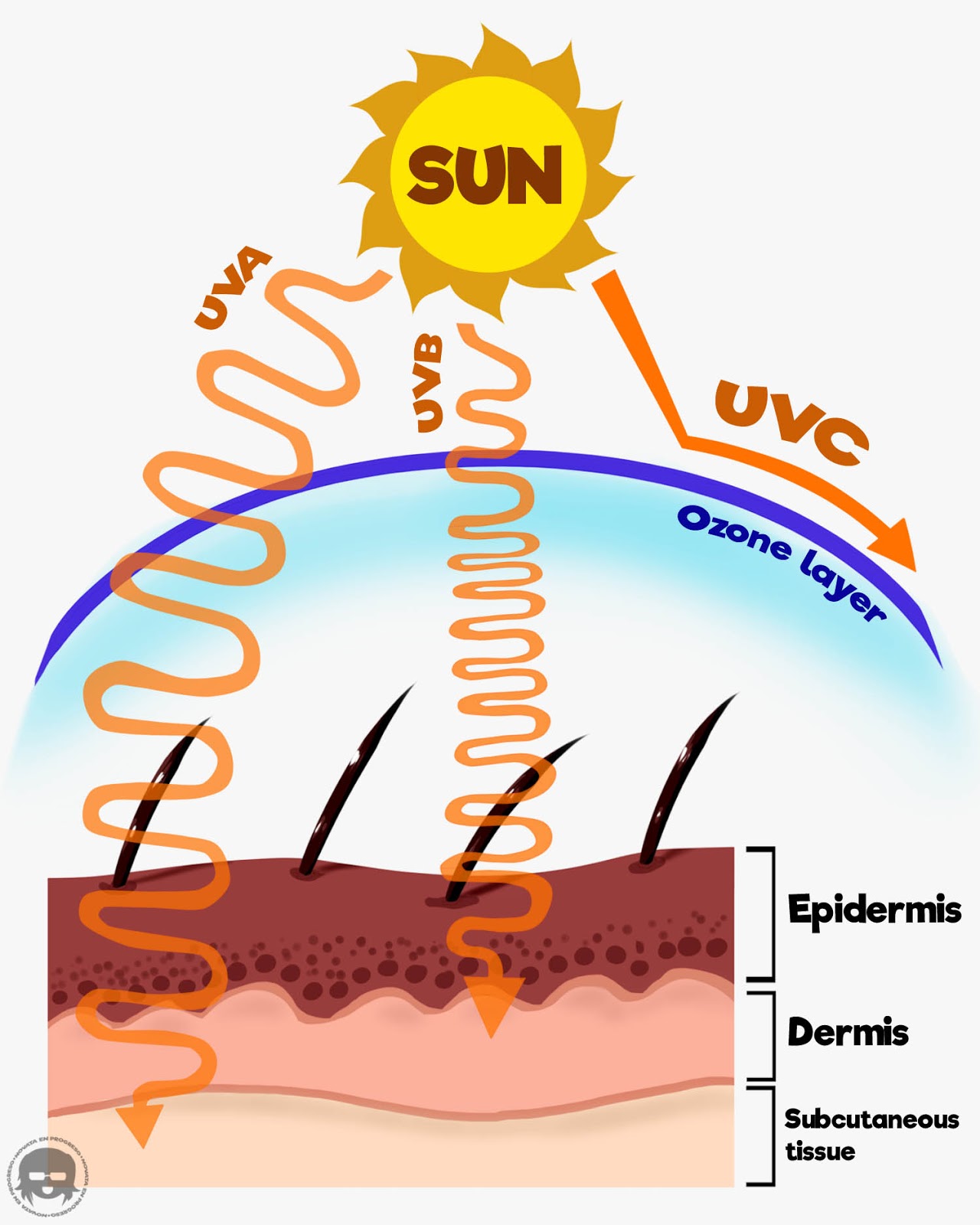 |
| Different types of UV rays and their reach in our skin. Adapted from Skincancer.org |
It has been shown that are responsibles of lesions like premature aging, damage to the eye level (including cataracts), skin cancer and suppression of the immune system. As well both UV rays damage skin at different ways, they also strengthen each other badly.
Despite are less intense than UVB, the UVA rays are from 30 to 50 times more prevalent on earth. They're presents during all year on daylight hours, and they can go trough clouds and glass. Due to their longer wavelenght, they can penetrate the skin deeper than UVB rays, altering collagen and elastin from dermis, generating the free radicals formation, generating wrinkles and premature aging of the skin too. Until today, there aren't studies that indicate some direct damages on epidermis (the most superficial skin layer), but they causes it on the basal skin layer (where all the skin cells are generated) which can be a starter for the skin cancer development:
Do you remember that tan color that we gain when we use to stay too much time at the sun or when someone goes to the sunbeds? Well, the guilty are UVA rays and this color, far from being a sign of healthy skin, indicates that there is a several accumulated damage in our celular DNA. If we expose our skin to the UVA constantly, the cells'll try to prevent the damages producing more melanine and, therefore, darkening the skin. This constant production could generate cell mutations, free radical formation and skin cancer development. So next time someone says you "you should toast a little to look healthy", please give them a hug... With a bear trap, please?
Do you remember that tan color that we gain when we use to stay too much time at the sun or when someone goes to the sunbeds? Well, the guilty are UVA rays and this color, far from being a sign of healthy skin, indicates that there is a several accumulated damage in our celular DNA. If we expose our skin to the UVA constantly, the cells'll try to prevent the damages producing more melanine and, therefore, darkening the skin. This constant production could generate cell mutations, free radical formation and skin cancer development. So next time someone says you "you should toast a little to look healthy", please give them a hug... With a bear trap, please?
The UVB presence changes depending of weather, place and time of the day. For example, in North America are presents from April to October, since 10 a.m until 4 p.m. These rays can reflect in surfaces like snow or ice, so if they reflect the damages'll get twice. It doesn't go trough glass like UVA rays.
The UVB rays are responsibles from skin redness and sunburns, generating damages to the most superficial skin layers. They're the master piece for the skin cancer development because they directly damage the celular DNA, maximizing the damages generated by UVA rays like tanning and premature aging.
If you're still being skeptical to this, let me introduce you to Bill McElligott:
If you're still being skeptical to this, let me introduce you to Bill McElligott:
 |
| Huffingtong Post photo. |
You could thing I've tried some Photoshop on this pic, buy sadly is far from the truth. Bill is a senior truck driver that drove on the road a long time ago during many long sunny days. Due to his job, the left side of his face was more exposed to the sun rays and, therefore, this was the side that received more damaged by the UVA rays. And we're talking about just the UVA rays, we'd have to see another lesions caused by the other UV rays.
When we're going to buy a new sunscreen, a lot of times we get caught by the colorful packages or the price (how much bucks are you going to save, TBH). But we must have in mind another important facts before:
SPF (Solar Factor Protection)
It's a measurement that allows to determinate the hability of a sunscreen to prevent the damage caused by UVB rays, in other words, it's useful to know how much time we could be exposed to sun rays until our skin get red.
For example, if your skin (without any kind of protection) takes 20 minutes to turn red, when you use a sunscreen with a 15 SPF we'll have that:
For example, if your skin (without any kind of protection) takes 20 minutes to turn red, when you use a sunscreen with a 15 SPF we'll have that:
20 minutes x 15 SPF = 300 minutes
300 minutes / 60 minutes = 5 hours
300 minutes / 60 minutes = 5 hours
If you use a sunscreen with 15 SPF, you'd have a protection time of 5 hours before your skin turns red.
SPF also influences the percentage of UVB rays it is able to keep at bay, so 15 SPF blocks 93% of these rays, 30 SPF blocks to 97% and 50 SPF to 98% of UVB rays. This range may not seem very important, but if you have skin cancer background in your family or if your skin is extra sensitive, believe me, it'll be a great support to protect you.
Said in that way, SPF could allow us to stay all day without reapplying the sunscreen, but the truth is that during daily activities our skin rubs our clothes, we're on the bus, eat on different places, touch objects and we're sweating, and those factors could generate that the barrier we create when we apply the sunscreen starts to degrading, or that the components starts to inactivate (as some organic sunscreens), so that's why it's important reapply at least each 2 hours. No matter how much water resistant or sweat resistant is the sunscreen, the best choice is to be sure that there's a new barrier that protects you and don't leave it as a #YOLO choice.
Broad Spectrum
It means that a sunscreen it's capable to protect you against both rays, UVA and UVB. Recently, a lot of sunscreens are looking for this feature, creating combinated sunscreen (that contains organic and inorganic components).
You always have to be sure that you're using a broad spectrum sunscreen, with SPF higher than 30 to outside activities.
You always have to be sure that you're using a broad spectrum sunscreen, with SPF higher than 30 to outside activities.
PPD (Persistent Pigment Darkening)
Established in Asia and Europe, is a value used to measure the sunscreen effectiveness against UVA rays. It is similar to SPF, with the difference that the most important value here is the time that it takes for your skin to tan. Numbers are also used (for example, a 10 PPD means that it will resist 10 times more than what it takes for your skin to tan).
PA (Protection Grade of UVA Rays)
Based on PPD, is a value created in Asia (specifically on japanese sunscreens) used to measure the sunscreen effectiveness against UVA rays. This value is measured asigning marks like "PA+", "PA++", "PA+++" ó "PA++++", and the more "+" signs you have, the more protection you offer against UVA rays.
Photostability
Most often seen on inorganic sunscreens. There are components that, once they have contact with sun rays, they start to degrade and the protection they offer start to decrease. When you get a sunscreen, make sure that it has components that gives it stability to these protective ingredients so they won't degrade easily. The most common are octocrylene,
bemotrizinol and bisoctrizole.
Your skin type
For example, inorganic sunscreens are mostly recommended for sensitive skin or special skin condition like rosacea, because their components are kind with skin and don't generate reactions like irritation, inflammation or something worst. These sunscreens are also recommended for acneic skin since zinc oxide helps to control the number of bacterial colonies that can raise your acne, plus it don't irritate or inflame your skin.
You can use different products with different SPF, but at the end the only SPF what will be worth is the product that has the greatest value. So always try to use an SPF value above 30.
By their display, sunscreens can be like creams, sprays, gel texture, pastry, oils, sticks, lotions and matifying powders.
By their composition, there are two type of sunscreens:
Organic, known as chemicals, and inorganic, known as physicals. They are called "organic" and "inorganic" due to basic chemical notions, since an organic component is that one that has carbon on their structure. The screens that contains zinc oxide or titanium dioxide don't contain carbon on their structures, so that's why they're called inorganic.
Each type of sunscreen have their advantages and disadvantages, but the dermatological research advances by leaps and bounds, and there are new sunscreens capable to bring us solar protection and an aesthetically pleasing appearance, with light texture and that don't generate secondary reactions.
 |
| Adapted from skincancer.org |
Organic and inorganic sunscreens works in a similar way: They absorb the sun rays and turns into heat, that is released on skin. However, the inorganic sunscreens and the new organic sunscreen generation are capable of repel a portion of UV rays that reach the skin (5%, approximately).
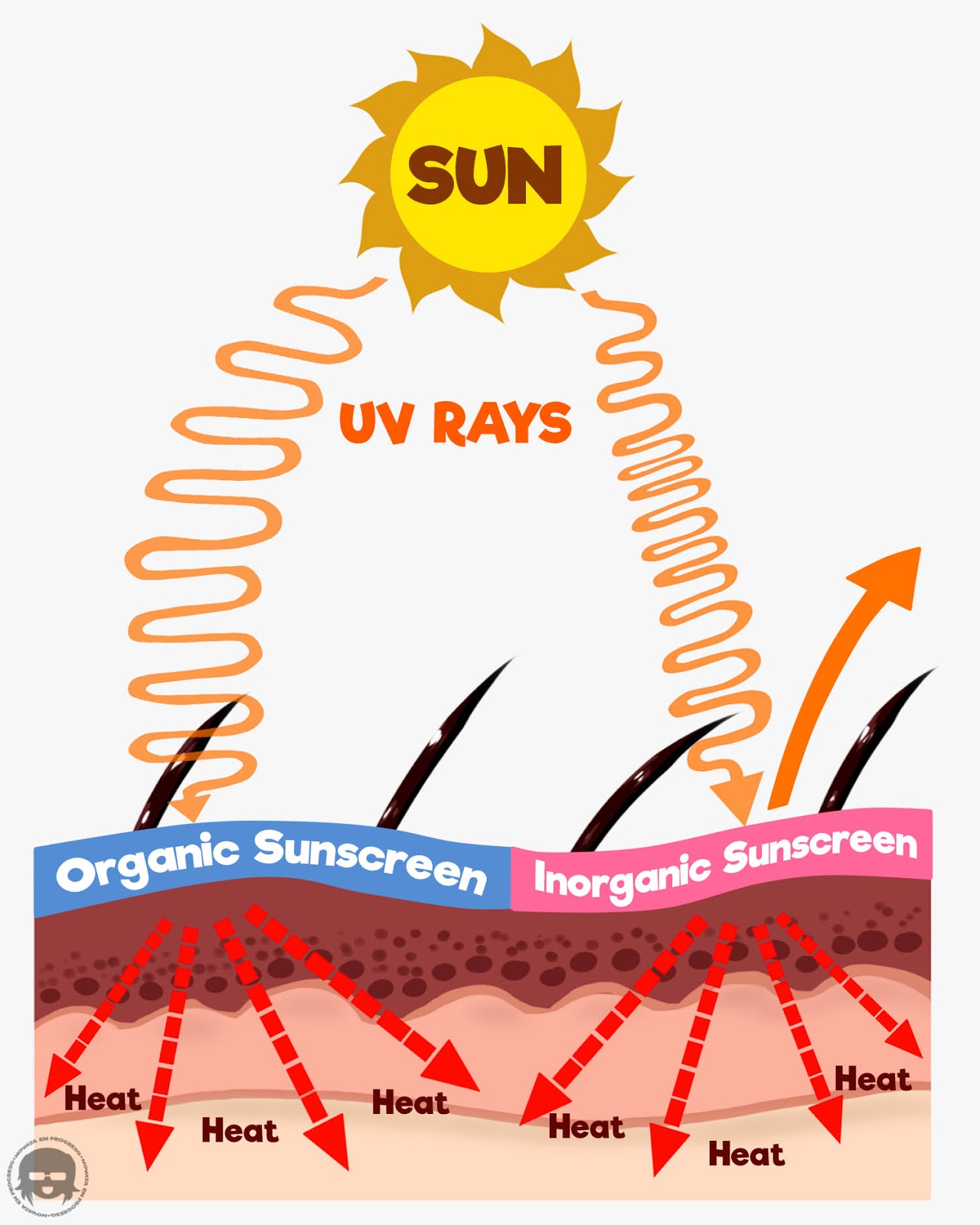 |
| Adapted from Skincancer.org and KindOfStephen |
Is not that simple, and in fact is not recommended. This may be due to:
- The base of both sunscreens could be different.
- Some of their components could not be compatible and, once they get in touch, they could destabilized, degrading both sunscreens faster.
No matter now may times you reapply the sunscreen or how much to apply, this'll happen always. If you'd like the full protection about both sunscreen types, you can buy a combined sunscreen.
Since most of the sunscreens are commercialized like cream type texture, the following is taken as reference:
For the face, it is taken as a reference measure to apply 1/4 teaspoon and wait a minimum of 15 minutes before leaving, since during this time the protector will create a barrier or "film" that will protect your skin from the sun's rays ( this applies to both organic and inorganic protectants).
For the whole body, take 2 tablespoons of sunscreen as a reference measure, and wait 30 minutes before leaving.
In both cases, the sunscreen must be reapplied every 2 hours.
Since sunscreen'll serve to protect you directly from the sun rays, you should try to keep it in the outermost part of your skin, so it should be the last step of your facial routine. This is also because the protector will form an occlusive barrier and if you want to place it before the moisturizer, the cream won't be absorbed and your skin could become dehydrated.
If you are going to use makeup, you should apply the sunscreen 15 minutes before (always remembering that the makeup must have SPF to protect your skin) applying it with sponge blenders and not rubbing it against the skin, because you could remove the sunscreen and goodbye safe protection.
For the face, it is taken as a reference measure to apply 1/4 teaspoon and wait a minimum of 15 minutes before leaving, since during this time the protector will create a barrier or "film" that will protect your skin from the sun's rays ( this applies to both organic and inorganic protectants).
For the whole body, take 2 tablespoons of sunscreen as a reference measure, and wait 30 minutes before leaving.
In both cases, the sunscreen must be reapplied every 2 hours.
Since sunscreen'll serve to protect you directly from the sun rays, you should try to keep it in the outermost part of your skin, so it should be the last step of your facial routine. This is also because the protector will form an occlusive barrier and if you want to place it before the moisturizer, the cream won't be absorbed and your skin could become dehydrated.
If you are going to use makeup, you should apply the sunscreen 15 minutes before (always remembering that the makeup must have SPF to protect your skin) applying it with sponge blenders and not rubbing it against the skin, because you could remove the sunscreen and goodbye safe protection.
 |
| Adapted from Lab Muffin |
Adults in general and children over 6 months of age. Babies younger than 6 months old shouldn't even be exposed to solar radiation, firstly because they're at a greater risk of dehydration, secondly, because some components of the sunscreen could generate adverse reactions to their skin. The best thing'll always be to have the babies in the shade, dress them with clothes that cover their bodies from the sun and consult a pediatrician before applying any sunscreen.
That's right! Remember that UV rays penetrate the terrestrial atmosphere and they could use those surfaces as magnifying glasses to enhance the damage. An 80% of these rays can be reflected in clouds or snow! So don't risk yourself and have sunscreen, even when you can't see the sun.
The best thing is apply a susncreen and besides your makeup with SPF. Remember that you must apply a good quantity of sunscreen and if you want to apply the same BB cream, CC cream or another makeup quantity, it won't cover totally the solar protection that your skin needs and plus, your makeup'll look cake and too much carged. And if you apply less makeup, there'll leave parts of your skin that won't be protected and there'll be irregular damage. Same way, you must verify that your makeup components won't cancel the sunscreen components function, and please don't use products with too much oil (like primers or makeup remover oil), since these can degrade the sunscreen function.
I know what you're thinking, but please don't do it! I know it sounds very tempting, but instead of being a cheaper and "natural" option, it could be something that generates damage to your skin in a non-far-away future. It is better to buy a good sunscreen that save some bucks now and spend twice later for medical treatments because of solar damages.
Why is not advisable to make your own sunscreen?
Even when you follow the instructions very well, there are some factors that you won't totally control, like:
- Mix all the ingredients until they are homogenized and have a perfect coverage (if they're not mixed with a centrifuge, they could be separated and far from protecting you, they'll expose you more to sun damage).
- Know the ingredients you're going to mix, their interactions and secondary reactions.
- The sunscreen pH to work properly at the pH of your skin.
- The final consistency of the sunscreen
- The separation and degradation of the sunscreen throughout the day.
- How do you spread on the skin
It is better to lose now a pair of dollars than lose a part of your life for a melanoma or for premature wrinkles. In addition, the sunscreen industry is growing rapidly and every day you can find good, nice and cheap options without having to prepare anything! Just a quick purchase of the super or at an online store and that's it.
The truth is that you'd have more chances to get a vitamin D defficiency for an unbalanced diet. If you are worried that your vitamin levels won't be adequate, you can try including foods such as salmon, eggs, cheese, milk, beef liver and orange juice in your diet. You can try supplements, but remember to go with your doctor before buying them.
If you want to take vitamin D directly from the sun, you can do it under certain conditions: Depending on the color of your skin, it is recommended the average time to expose yourself to the sun and take the vitamin D needed for your body. You can sunbathe exposing parts of your body like arms and legs for a certain time, since it's not necessary to be too much time under the sun rays to absorb vitamin D. If your skin is very pale, with 5 minutes of activity abroad for 2-3 days a week you'll have enough. However, if your skin is darker, you may need more time (there is talk of even 10-15 minutes in the sun for 2-3 days a week). It's recommended that during this sun exposure, instead of resting, you should try doing activities in order to generate more vitamin D.
If you want to take vitamin D directly from the sun, you can do it under certain conditions: Depending on the color of your skin, it is recommended the average time to expose yourself to the sun and take the vitamin D needed for your body. You can sunbathe exposing parts of your body like arms and legs for a certain time, since it's not necessary to be too much time under the sun rays to absorb vitamin D. If your skin is very pale, with 5 minutes of activity abroad for 2-3 days a week you'll have enough. However, if your skin is darker, you may need more time (there is talk of even 10-15 minutes in the sun for 2-3 days a week). It's recommended that during this sun exposure, instead of resting, you should try doing activities in order to generate more vitamin D.
En
general, los reportes sobre daños generados por protectores solares son
en estudios In Vitro y en donde se replican situaciones de exposición
solar en animales como ratas y cobayos, donde las cantidades de los
ingredientes de los protectores solares no son las mismas (ya que se
realizan pruebas por cada ingrediente por separado y para esto se aplica
una dosis mayor a la que
contiene el protector en realidad) y en los estudios que se han
realizado sobre
nanopartículas de protectores inorgánicos no se ha encontrado evidencia
de que sean capaces de ingresar a torrente sanguíneo. Lo que sí podría
presentarse sería una reacción
alérgica, pero esto es sólo si hay algún componente que genere alguna
reacción en tu piel (como en el caso de los protectores orgánicos).
In general, the reports on damages generated by sunscreens are In Vitro studies, where situations of sun exposure are replicated in animals such as rats and guinea pigs, and the amounts of sunscreen ingredients are not the same (since they perform tests for each ingredient separately and for this, they apply a higher dose to the one that contains the protector in reality) and in the studies that have been carried out on nanoparticles of inorganic sunscreens, no evidence has been found that they are capable of entering the torrent blood. It could be an allergic reaction, but this is only if there is a component that generates a reaction in your skin (as in the case of organic sunscreens).
In general, the reports on damages generated by sunscreens are In Vitro studies, where situations of sun exposure are replicated in animals such as rats and guinea pigs, and the amounts of sunscreen ingredients are not the same (since they perform tests for each ingredient separately and for this, they apply a higher dose to the one that contains the protector in reality) and in the studies that have been carried out on nanoparticles of inorganic sunscreens, no evidence has been found that they are capable of entering the torrent blood. It could be an allergic reaction, but this is only if there is a component that generates a reaction in your skin (as in the case of organic sunscreens).
It's recommended that you place the sunscreen in a cool area, away from direct sun exposure, and if you are going to carry the sunscreen when you leave, keep it in containers or bags that won't be directly exposed to the sun, always keeping it in shaded areas . Keep it away from the same form of excessive heat too.
As for the expiration date, the package must have printed the expiration date of the product. Never use a product whose expiration date has already passed, because nobody assures you that the ingredients are still viable or they can generate severe skin reactions to you.
As for the expiration date, the package must have printed the expiration date of the product. Never use a product whose expiration date has already passed, because nobody assures you that the ingredients are still viable or they can generate severe skin reactions to you.
If you want to protect yourself in a complete way, here are some useful tips:
- Try not to expose yourself too much in the sun, especially between 10 a.m. and 4 p.m, when the sun rays are most intense. Always look for shady places where you don't have total contact. Also avoid sunbeds.
- Perform a medical checkup periodically to assess your health.
- In addition to sunscreen, clothing can help to protect you from the sun rays. When you can, wear long-sleeved clothing, long pants, sunglasses and wide caps that cover your face. Remember that the protection that the clothes give you'll be similar to a 5 SPF, so don't settle with that and use the sunscreen as well.
- Add antioxidant products to your skin care routine and diet, as they'll help eliminate free radicals generated by UV rays. Vitamin C, vitamin E, glutathione, reservatrol and vitamin B3 are some compounds that will help you to diminish the damages and at the same time they will help you in problems of inflammation, acne, dryness, stains, dehydration and hyperpigmentation.
The sun is a powerful enemy from long time ago, and has damaged our health and skin severely. But fortunately, during these days we have so much technology that's trying to reduce this fact as much as possible.
(I must be clear, this is not a commercial and I'm not receiving money for share this app, but I think it's great and deserves to be known in all world, it's a way to be grateful with an amazing free app).
 |
| QSun official logo |
I've tested this cellphone application and I think it's really useful for skincare. Its name is QSun, and it's a basic multitask app that serves to verify the hours which there will be greater intensity of UV rays, giving you advices about how to protect yourself depending on the area where you live, the type of clothes you're wearing and notifying you about possible changes. It also brings options so you can check the weather at a certain time of the day and a tab to determine the percentage of vitamin D with will you have (this option is still in the Early Access period). The part I like the most is where you determine your age and the percentage of health of your skin by taking a picture.
 |
| This is a diagram that can help you to know how many teaspoons of sunscreen you should use for the type of clothing and / or protection you wear during the day (QSun app photocapture) |
 |
| If you don't know what type of skin you have, you can access a questionnaire that will help you determine it. This will also help you to customize the application according to your skin tone, health conditions, weight, height and sex (QSun app photocapture) |
 |
| My favorite part of this app. Take a selfie and determinate your age according to your dark circles, spots and acne. Thanks for taking a few years off me ;) (QSun app photocapture) |
 |
| In this general table you can see the hours where there is greater exposure to UV rays, as well as tips to avoid burns or sun damage. It also indicates the hours you have left before your skin turns red (QSun app photocapture) |
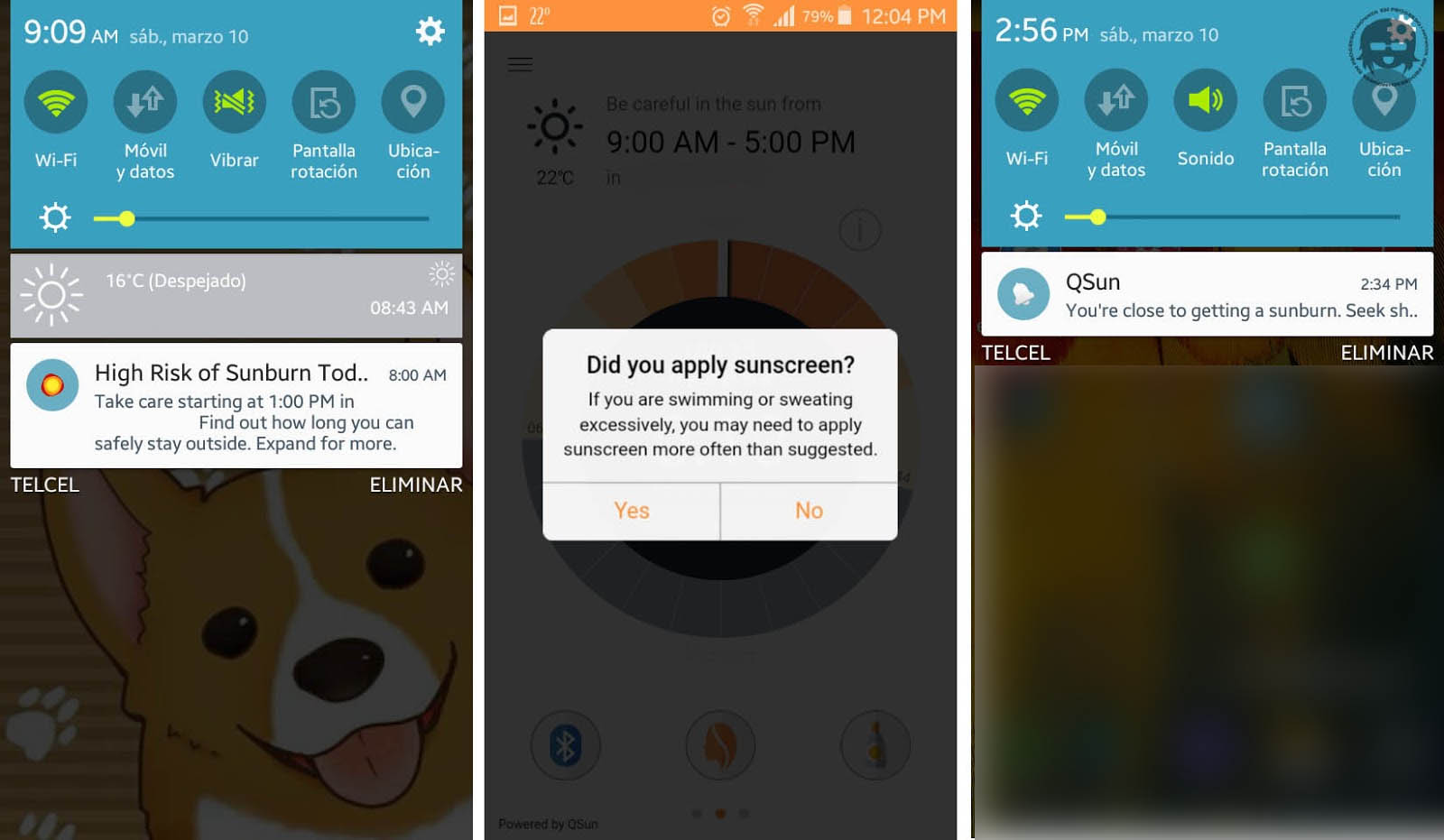 |
| You can also receive notifications about the hours were'll be more UV rays exposition, if you want to mark the time from which you started using sunscreen and a reminder for reapplication (QSun app photocapture) |
I truly recommend it, it can be useful as a friendly reminder to apply the sunscreen and to control the hours where you can expose to the sun without too much damage.
The creators have a KickStarter and they're developing a device capable of determining the percentage of vitamin D and sun exposure that you should have during the day without affecting your health, if you are interested in supporting them you can see their project and donate here.
 |
| Original image from QSun |
 |
| Original image QSun |
 |
| Original image from QSun |
 |
| Original image from QSun |
I hope that this post can be useful for you to start using sunscreen in your skincare routine, since it's a practical and kinda cheaper way to take care of your health and your beautiful looking.
What other theme would you like to read on this blog? I promise I'll do my best to bring you useful info ヾ(@⌒▽⌒@)ノ.
What other theme would you like to read on this blog? I promise I'll do my best to bring you useful info ヾ(@⌒▽⌒@)ノ.
Enjoy Spring!
+ SOURCES +
Arellano-Mendoza, M.I., Lim, H.W., Stengel, F. (2017). Current challenges in photoprotection. Journal of the American Academy of Dermatology. 76 (3). Disponible en: http://www.jaad.org/article/S0190-9622(16)30882-9/fulltext
Binks,
B.P., Brown, J., Crowther, J.M., Fletcher, P.D.I, Johnson, A.J.
Marinopoulos, I., Thompson, M.A. (2016). Evaporation of Sunscreen
Films: How the UV Protection Properties Change. ACS Applied Materials & Interfaces 2016 8 (21). Disponible en: https://pubs.acs.org/doi/abs/10.1021/acsami.6b02696
Cho, C. (2015). The little book of skincare. Ed. HarperCollins Publishers Australia. Sydney, Australia. Pp. 51-56.
Delange,
J. (2012). Bill McElligott, delivery truck driver, has severe sun
damage on one side of his face (Photo). The Huffington Post Canada.
Disponible en:
www.huffingtonpost.ca/2012/06/06/bill-mcelligott-sun-damage_n_1573546.html
Dermatalk. (2013). SPF and PA+++ in Sunscreen: What does it Indicate? Disponible en: http://www.dermatalk.com/blogs/skincare/spf-and-pa-rating-in-sunscreen-what-does-it-indicate/
Draelos, Z.D. (2012). What is the appropiate dry-down time for sunscreen? Dermatology Times. Disponible en: http://dermatologytimes.modernmedicine.com/dermatology-times/news/modernmedicine/modern-medicine-feature-articles/what-appropriate-dry-down-tim
Epstein, J.H., Wang, S.Q. 2017. UVA and UVB. Disponible en: https://www.skincancer.org/prevention/uva-and-uvb
Food
and Drug Administration (FDA). (2016). Should you put screen on
infants? Not usually. Disponible en:
https://www.fda.gov/ForConsumers/ConsumerUpdates/ucm309136.htm
Food
and Drug Administration (FDA). (2017). Sunscreen: How to help protect
your skin from the sun. Disponible en:
https://www.fda.gov/Drugs/ResourcesForYou/Consumers/BuyingUsingMedicineSafely/UnderstandingOver-the-CounterMedicines/ucm239463.htm
Foxon-Hill, A. (2012). The trouble with making your own sunscreen. Realize Beauty 2012. Disponible en: https://realizebeauty.wordpress.com/2012/12/30/the-trouble-with-making-your-own-sunscreen/
Halpern,
A.C. (2011). The Impact of the FDA Final Regulations on Sunscreen. The
Melanoma Letter Summer 2011 29 (1). Pp. 3. Disponible en:
https://www.skincancer.org/media/legacy/stories/melanoma_letter/MelanomaLetter_29_1.pdf
Kind Of Stephen. (2016). "Physical" vs. "chemical" sunscreens and other sunscreen myths. Disponible en: http://kindofstephen.com/physical-vs-chemical-sunscreens-myths/
Lab Muffin (2017). All your Sunscreen and Make-Up questions answered.
Disponible en:
https://labmuffin.com/video-sunscreen-make-up-questions-answered/
Lab Muffin (2017). Why DIY sunscreen doesn't work. Disponible en: https://labmuffin.com/video-why-diy-sunscreen-doesnt-work/
Lab Muffin. (2017). Why do I need to apply sunscreen before sun exposure? Disponible en: https://labmuffin.com/need-apply-sunscreen-sun-exposure/
McNeil, A.N., Wesner, E. (2016). Sun Protection and vitamin D. The Skin Cancer Foundation Journal 2016. 5 (8). Disponible en: https://www.skincancer.org/healthy-lifestyle/vitamin-d/damage
Petersen, B., Wulf, H.C. (2014). Application of sunscreen - theory and reality. Photodermatology, Photoimmunology & Photomedicine 2014 2(3). Disponible en: http://onlinelibrary.wiley.com/doi/10.1111/phpp.12099/full
Reiche, L. (2007). How to choose and use a sunscreen. DermNet NZ 8 (12). Disponible en: https://www.dermnetnz.org/topics/how-to-choose-and-use-sunscreen/?utm_source=TrendMD&utm_medium=cpc&utm_campaign=DermNet_NZ_TrendMD_1
The Klog. (2017). SPF, PPD, PA, UVAPF: What Does Your SPF Label Actually Mean? Disponible en: https://theklog.co/spf-meaning/
The
Skin Cancer Foundation. (2012) Sunscreens Explained. Disponible en:
https://www.skincancer.org/prevention/sun-protection/sunscreen/sunscreens-explained
Therapeutic
Goods Administration (2016). Literature Review on the safety on
titanium dioxide and zinc oxide nanoparticles in sunscreens. Disponible
en: https://www.tga.gov.au/literature-review-safety-titanium-dioxide-and-zinc-oxide-nanoparticles-sunscreens
Special thanks to QSun who allow me to use their images and for let me test their free app to complement this post.
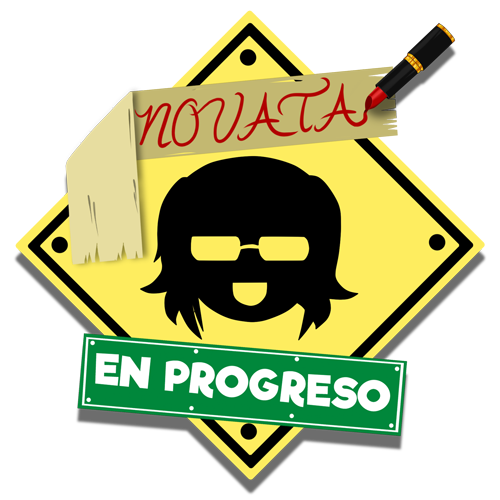



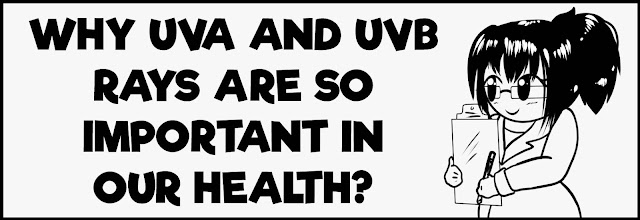






































0 comentarios
Me gustaría saber qué opinas 💖 Por favor no dejes enlaces, pasaré a visitar tu perfil 😊
I would like to know what do you think 💖 Please don´t leave links, I´ll visit your profile 😊